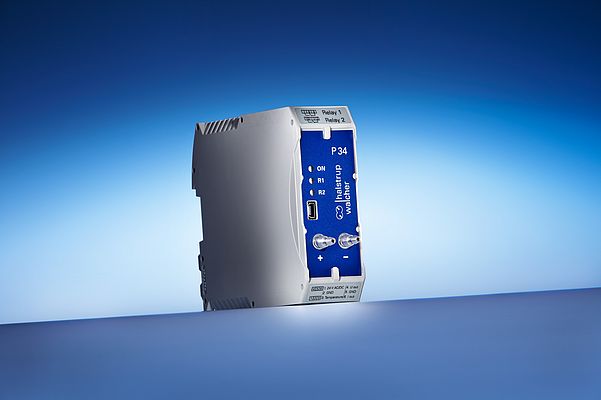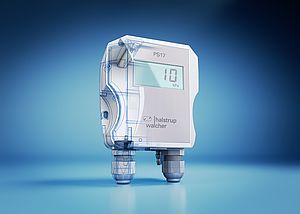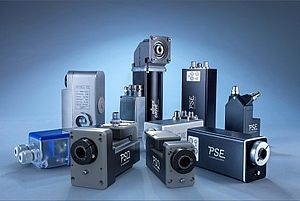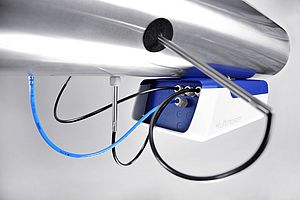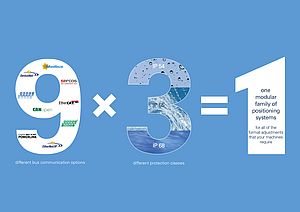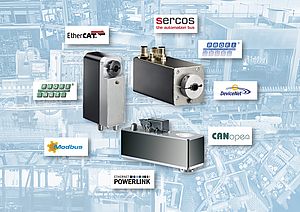Cleanroom operating requirements are becoming ever more stringent. The maintenance of overpressure is a good example of this process at work. The objective is to prevent any inflow of contaminated air by maintaining stable pressure cascades. Facilities with a number of cleanrooms (or plants with a number of mini-environments) create areas with different pressure levels in order to provide the greatest possible protection for the most sensitive zones.
Overpressure monitoring
The obligation to ensure continuous monitoring of overpressure described in standard DIN EN ISO 14644 cannot be met simply by installing a display. Where are the regulating countermeasures if the overpressure falls below the critical threshold value? It is also unrealistic to expect that operating personnel will be close at hand to rectify the situation at precisely the moment that this happens. Consequently, it is now standard practice to measure differential pressure and transmit this signal to a control module.
Static vs dynamic transmitters
Solutions based on either "static" differential pressure transmitters or a "dynamic" approach are available on the market for this purpose. The latter is based on the overflow principle – a small quantity of air flows from one room into the next; the velocity of flow is recorded and used to calculate the differential pressure. This "dynamic" method has two important disadvantages:
- The dynamic measurement principle requires an outflow of air from the higher pressure to the lower pressure room. Thus an exchange of air takes place between the rooms. However, it is a frequent requirement that each cleanroom must have a separate, high quality supply of filtered air in order to prevent cross-contamination. This is not a problem for pressure transmitters that use static sensors.
- Where regulation of more than two cleanrooms is required, it is important to ensure that the pressure intervals are maintained at stable levels. The dynamic principle can only be used to calculate the differential pressure of one room in relation to its neighbouring room. There is no common pressure reference value ("pneumatic zero potential"). Static differential pressure transmitters offer an elegant solution to this problem, e.g. by pneumatically connecting the negative pressure ports of all neighbouring pressure transmitters.
Different approaches
However, there are differences even between "static" differential pressure transmitters and the details separate the men from the boys. Measuring tiny pressures in the range below 30 or even 10 Pascal reliably and over many years is anything but technological "child's play". By way of comparison: normal air pressure of approx. 1 bar is equal to around 100,000 Pascal, so 10 Pascal are a vanishingly small fraction of the pressure of our environment! Most "static" differential pressure transmitters have two key weaknesses in this measurement range:
- Most pressure transmitters with static measurement cells do not offer a stable measurement range over the long term. Over time, the measurement value will "wander" away from 10 Pascal, for example, and eventually result in an error of several Pascal.
- At the same time, they do not guarantee zero point stability. This means that over time the zero signal (i.e. a differential pressure of zero Pascal) will be subject to a drift, which can often be as high as 1 to 2 Pascal per year.
Measurement stability
The measurement technology specialist halstrup-walcher has over forty years of experience in this area and exploits this know-how in refined and reliable solutions to both these problems. For example, improvements made to the membrane design over many decades have produced world class measurement range stability. At the same time, solenoid valves ensure that the zero point is always maintained with perfect accuracy. This is done by a regular, automatic "zeroing" process performed with the help of solenoid valves. Every measurement is therefore absolutely reliable even after years of operation.
Old trends
Until a few years ago there was a trend in cleanroom measurement technology: so-called "panels" with integrated sensors. These panels are set into the cleanroom wall and display a variety of climate data such as temperature and humidity as well as overpressure. The pressure and usually the other values are measured directly at the panel. These instruments are not as frequently used today because the most advantageous position for the sensors may not be the ideal installation point for the panel. For example, the preferred location for measuring humidity and temperature is in the exhaust air duct because the value obtained here reflects the climate of the room as a whole. Furthermore, it is more convenient to install differential pressure sensors in a neighbouring control cabinet than directly behind a wall mounted panel.
Differential pressure transmitters
Installing differential pressure transmitters in a control cabinet offers two advantages:
- The "pneumatic zero potential" described above (for maintaining clear pressure intervals in several zones) is extremely easy to implement. All the pressure transmitters for neighbouring rooms are installed next to each other in the control cabinet and a short hose connection between the neighbouring pressure transmitters is all that is required to provide the same pressure reference value.
- Calibration (which is obligatory every year in many cleanrooms) takes place outside the cleanroom. In addition, all the pressure transmitters are conveniently arranged next to each other for the calibration process. This saves a considerable amount of time.
Choosing the right transmitter
When selecting the appropriate differential pressure transmitter for a control cabinet, professional cleanroom equipment suppliers ensure that the unit has a compact design, ideally a narrow "disk module", that permits a large number of units to be installed alongside each other. Not only the size but also the accuracy of the pressure transmitter must meet the required standards (min. 0.5% of the max. value, or even 0.2% of the max. value for exceptionally critical applications). Wiring and the ease of replacing modules during servicing are also important criteria to consider when selecting a suitable pressure transmitter.
The new P 34 differential pressure transmitter from halstrup-walcher for control cabinet installation is the optimum solution to all three of these requirements:
- It guarantees first class data accuracy (high stability membrane, automatic zeroing) even for the smallest measurement ranges of just a few Pascal.
- The extremely compact design requires only minimal space in the control cabinet.
- Cables are connected to coded, non-confusable terminal bars so that initial installation and replacement of modules can be performed quick and correctly.
One further feature demonstrates that the P 34 was designed by practical engineers for practical use: the measurement value can be read out via two galvanically separated analogue outputs. This enables the building control system and the monitoring system to receive the measurement signal independently of each other.


